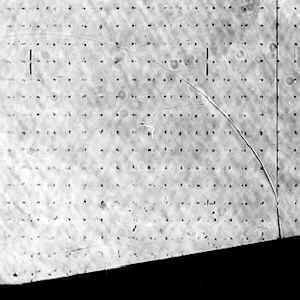Laboratory studies
DM&A have enjoyed a long association with the Shock Studies Laboratory at the
University of Victoria (Dr J.M. Dewey, Professor Emeritus, Department of Physics and
Astronomy). The laboratory uses shock tubes for the study of shock-shock and
shock-structure interactions, employing high-speed multiframe shadowgraph, schlieren and
particle tracer photography and holographic inteferometry.

Combined schlieren and particle tracer photography of a
plane shock reflecting from a 10-degree wedge. The primary and reflected shock fronts and
the Mach stem are seen on the right. The mirror in the background has a grid of small
holes drilled in it, through which smoke was injected just before shock arrival to act as
flow tracers. The holes also serve as a reference grid for checking optical distortion.
The size of the view window in the shock tube is 25x30cm (the picture above is a partial
view).
 The Shock Studies Laboratory is used to study the fundamental aspects of
shock and blast waves. Specialized high-speed cameras have been developed for research in
the laboratory, including a laser/video system capable of 20,000 pictures per second.
Automatic particle tracking methods in three dimensions using stereoscopic photography
have also been developed.
The Shock Studies Laboratory is used to study the fundamental aspects of
shock and blast waves. Specialized high-speed cameras have been developed for research in
the laboratory, including a laser/video system capable of 20,000 pictures per second.
Automatic particle tracking methods in three dimensions using stereoscopic photography
have also been developed.
 DM&A have adapted their large-scale 'outdoor' photogrammetric
transformation software to the schlieren optics used in the Shock Studies Laboratory, and
have done photogrammetric analysis of films made in other laboratories, such as the Ernst
Mach Institute in Germany and the Norwegian Defense Construction Service facility in Oslo.
In addition to shock tube experiments, DM&A have analyzed films from spark chambers
and micro-explosions.
DM&A have adapted their large-scale 'outdoor' photogrammetric
transformation software to the schlieren optics used in the Shock Studies Laboratory, and
have done photogrammetric analysis of films made in other laboratories, such as the Ernst
Mach Institute in Germany and the Norwegian Defense Construction Service facility in Oslo.
In addition to shock tube experiments, DM&A have analyzed films from spark chambers
and micro-explosions.
